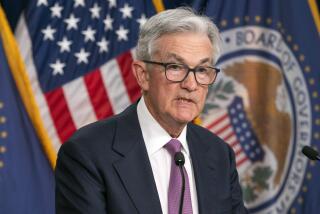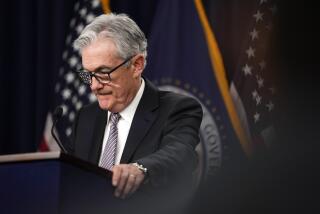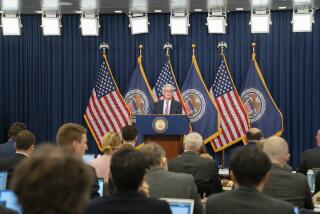Japan Discount Rate Up; U.S. Dollar Keeps Rising : Tokyo’s Hike to 3.25% Is 1st in 9 Years and Meant to Cool Inflation Threat
- Share via
TOKYO — In the first such increase in nine years, the Bank of Japan on Tuesday raised its central discount rate by 0.75 percentage point to 3.25%, signaling the end of an era of extremely low interest rates but not the end of the dollar’s rise against the yen.
For the second straight trading day after word of the rate increase was leaked to the Japanese media last Friday, the dollar moved up Tuesday on the Tokyo Foreign Exchange Market, gaining 0.22 yen to close at 143.10. The dollar had gained 2.48 yen Monday, nearly 2%. In New York, the dollar traded at 142.75 yen, down from earlier in the day but up from 141.10 on Friday.
Satoshi Sumita, governor of the central bank, described the interest rate increase as a move designed to nip inflation in the bud.
Since February, 1987, the central discount rate, which the bank charges on loans to commercial banks, had been 2.5%, the lowest ever in Japan and the lowest among developed nations.
Increases in the relative value of the dollar in recent months have forced Japanese to pay more in yen for foreign goods, driving up prices of oil and other imports, Sumita noted.
Expects More Growth
Finance Minister Tatsuo Murayama said the central bank is following a trend in the market, where rates have been rising. He insisted that the rate increase measure “will continue the maintenance of domestic-led growth . . . in line with the tenor of international coordination” and Japan’s promises to spur imports and reduce its trade surpluses.
Higher interest rates usually dampen growth, but Sumita said personal consumption and equipment investment are strong enough here so that “if price stability is preserved, economic growth will continue.”
He said the central bank will start checking commercial banks’ loan plans in order to prevent excessive lending of the sort that has contributed to an explosion of land and stock prices.
Business leaders were divided in their reaction. Eishiro Saito, chairman of the Federation of Economic Organizations, said: “Economic conditions are extraordinarily smooth. There was no need to change policy.”
But Takashi Ishihara, head of the Japan Assn. of Business Executives, called the move overdue.
Wholesale prices in the first 10 days of May rose 3.1% compared to the same period last year. They had risen 2.5% in April, and the 10-day May increase was the largest since January, 1981.
The central bank said the erosion of the yen’s value had pushed up import prices in yen by 8.8%, compared to the same period last year. Sumita also complained that price stability was being threatened by a tightening supply of labor.
The move appeared to be focused more on concern about possible inflation in Japan than on the nation’s trade surplus. Japanese manufacturers have demonstrated their ability to increase exports even with exchange rates around 120 yen to the dollar.
The central bank stood aloof as the dollar moved up in value from around 125 yen in January to about 130 from February through April. Only when the dollar exceeded the 140-yen level in early May did the bank start intervening in an attempt--futile thus far--to prop up the yen.
Surpluses Growing
As the relative value of the dollar rises, Japanese manufacturers receive more in yen for products they sell abroad, but they have to pay more yen for things they import.
In the last nine months, Japan’s trade surpluses have resumed their expansion--so much so that exports are again contributing to gains in the gross national product, Deutsche Bank Capital Markets (Asia) Ltd. said in a report this month. Between 1986 and 1988, exports were a drag on the economy, with domestic demand accounting for all the growth.
“At the current $8.6-billion monthly rate, Japan is set to run a (trade) surplus of $103 billion in 1989, a 9% increase from 1988,” the report said.
With exporters “having largely completed the adjustment” to a higher value for the yen than now prevails, the West German brokerage firm predicted that measures to strengthen the yen will gradually “prove incapable of reversing the powerful dynamic now driving the expansion of the Japanese trade surplus.”
“As a result,” it warned, “a still more intense and economically destabilizing trade conflict (lies) ahead.”
Already, some businessmen are expressing fear that the central bank may be forced to raise the discount rate again. Asked about this possibility, Sumita told reporters that he is giving “absolutely no thought” to such a move.
Sumita acknowledged that the rate increase might not drive up the value of the yen immediately, but he said it “will contribute to exchange rate stability in the long run.”
On Monday, Toyoo Gyoten, vice finance minister for international affairs, said a rising dollar would stir fear among U.S. industries about again losing their international competitiveness. He predicted that if the dollar continues to rise, the U.S. government will take countermeasures.
JAPAN’S CENTRAL DISCOUNT RATE
Darkened entries with asterisk indicate the all-time high and low. Feb. 19, 1980: 7.25%
*March 19, 1980: 9.0%
Aug. 20, 1980: 8.25%
Nov. 6, 1980: 7.25%
March 18, 1981: 6.25%
Dec. 11, 1981: 5.5%
Oct. 22, 1983: 5.0%
Jan. 30, 1986: 4.5%
March 10, 1986: 4.0%
April 21, 1986: 3.5%
Nov. 1, 1986: 3.0%
*Feb. 23, 1987: 2.5%
May 31, 1989: 3.25%
Source: Bank of Japan
More to Read
Inside the business of entertainment
The Wide Shot brings you news, analysis and insights on everything from streaming wars to production — and what it all means for the future.
You may occasionally receive promotional content from the Los Angeles Times.










